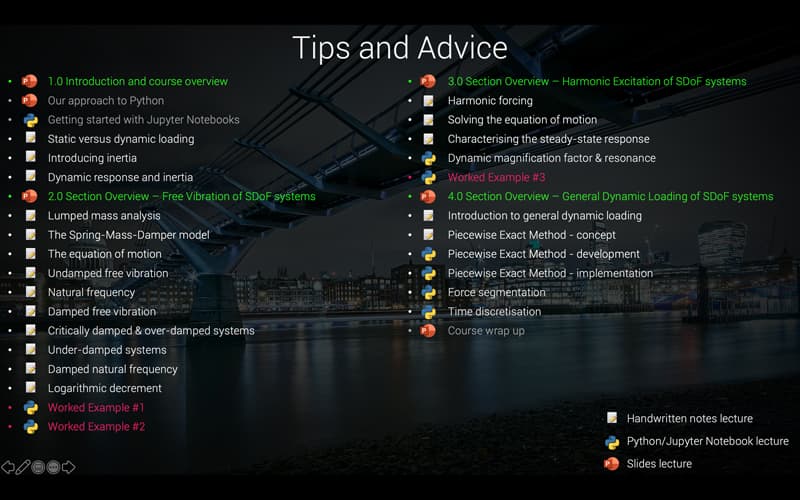In this course, we'll be driving towards two main objectives:
- To help you build a solid understanding of the core concepts in structural dynamics
- To equip you with some practical tools you can deploy to analyse real-world dynamic structural behaviour
In this short intro lecture I'll give you an overview of the course structure and a better idea of what to expect. I'll also give you some tips and advice on how to get the most from the course.
This course is broken into four sections:
Section 1 - Introduction to Dynamics
In the introduction section we'll briefly discuss the difference between static and dynamic analysis and in particular we'll review the role inertia plays in dynamic analysis. By the end of the first section you should understand when and why we carry out a dynamic versus static structural analysis.
Section 2 - Free Vibration of Single-Degree-of-Freedom Systems
In the next section, we'll focus on free vibration of Single-Degree-of-Freedom (SDoF) systems. We'll start by describing what a SDoF system is and then start to develop equations that describe its dynamic behaviour. Understanding the mechanics of SDoF systems is one of the essential prerequisites to any dynamic analysis.
Section 3 - Harmonic Excitation
The study of free vibration in section two will be followed by the study of forced vibration in section 3. In particular, we'll discuss harmonic excitation. Understanding the mechanics behind harmonic excitation is also going to be essential for any further study of structural dynamics.
Up to this point our attention has focused on classical closed-form solutions to the equation of motion. In other words we've been able to derive equations that describe the dynamic behaviour of our systems for any instant in time. While this was a necessary starting point, in reality we rarely use completely closed-form solutions. The most interesting and challenging dynamic analyses typically require the use of numerical solution methods; one of which we'll explore in section 4.
Section 4 - General Dynamic Loading
In the final section, we'll develop our understanding of a highly versatile numerical solution technique known as the piecewise-exact method. We'll develop an exceptionally versatile algorithm to calculate the dynamic response of a system to general dynamic loading, i.e. loading that can't be neatly described by a mathematical equation.
After completing this course, you will not only have a sound grasp of the fundamental theory of SDoF oscillators but you'll have developed the practical tools to put this knowledge into practice using numerical solution techniques, implemented in Python.
Split between written notes and Jupyter notebooks
We'll be using the Jupyter development environment to write our Python code. We'll speak a bit more about that in the next lecture. You should note that we'll be diving into Python more in the second half of the course. We'll use pen and paper to present the discussion and develop our understanding in the first half. So, if you're keen to get coding, you'll need to have a little patience - we need to cover the theory before we can put it to good use with Python a little later in the course. You can see a breakdown of which lectures are Python based and which are traditional note based below.

Fig 1. Lecture breakdown.
Downloading Jupyter Notebooks
In most cases, the Jupyter notebooks associated with each Python lecture can be downloaded as a resource from the lecture's resource panel. For the worked examples, you're strongly encouraged to attempt to solve the question yourself before watching me develop a solution.
Take your time
Take your time and set realistic expectations. Thousands of students will ultimately take this course and you all have different starting points and background knowledge. For some of you this will be light revision and you will breeze from the first to last lectures. For others, it will be a first introduction to structural dynamics and each lecture completed will feel like a mini-win. If you're in the second group, make sure to take your time and don't rush through the course just to get to the end.
Watch each lecture and really try to digest what we're discussing before moving on, re-watch the lectures, supplement a lecture topic by referring to a dynamics text to reinforce your understanding. Don't expect to grasp everything straight away. Dynamics is one of the more challenging structural analysis topics - give yourself plenty of time to let it sink in and don't lose faith if and when it starts to get challenging.
And finally, if you have any questions you can ask them in the lecture Q&A or comments section (follow the link in the resource panel above). If you have a specific question about something covered in a lecture, let me know the time in the lecture that your question refers to, that will help me answer it as effectively as possible.
So that's the plan, let's dive straight in. I'll see you in the lecture.